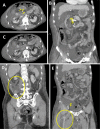Pancreatic Fistula Extending into the Thigh Caused by the Rupture of an Intraductal Papillary Mucinous Adenoma of the Pancreas
- PMID: 28154275
- PMCID: PMC5348455
- DOI: 10.2169/internalmedicine.56.7422
Pancreatic Fistula Extending into the Thigh Caused by the Rupture of an Intraductal Papillary Mucinous Adenoma of the Pancreas
Abstract
We herein report the first case of a pancreatic fistula extending into the thigh caused by the rupture of an intraductal papillary mucinous neoplasm (IPMN) of the pancreas. An 80-year-old man was suspected to have necrotizing fasciitis because of right femoral pain. Computed tomography showed fluid retention from the pancreatic head to the right iliopsoas muscle and an IPMN at the pancreatic head. The findings of endoscopic retrograde pancreatography led to the suspicion of a minor leak and a pancreatic stent was placed. The patient died due to an uncontrollable infection. A pathological autopsy showed a pancreatic fistula extending into the thigh that had been caused by the rupture of the IPMN.
Figures








Similar articles
-
Hepatobiliary and Pancreatic: Intraductal papillary mucinous neoplasm rupture: A rare cause of pancreatic fistula.J Gastroenterol Hepatol. 2020 Apr;35(4):528. doi: 10.1111/jgh.14882. Epub 2019 Dec 10. J Gastroenterol Hepatol. 2020. PMID: 31822035 Review. No abstract available.
-
Malignant intraductal papillary mucinous neoplasm of the pancreas with multiple pancreatogastric fistulas: a report of 2 cases with different features.Gastrointest Endosc. 2007 Oct;66(4):854-7. doi: 10.1016/j.gie.2007.01.019. Epub 2007 Aug 24. Gastrointest Endosc. 2007. PMID: 17719044 No abstract available.
-
Biliopancreatic fistula and abscess formation in the bursa omentalis associated with intraductal papillary mucinous cancer of the pancreas.Int J Clin Oncol. 2009 Oct;14(5):460-4. doi: 10.1007/s10147-008-0864-1. Epub 2009 Oct 25. Int J Clin Oncol. 2009. PMID: 19856058
-
A case of pancreaticobiliary fistula associated with an intraductal papillary mucinous neoplasm of the pancreas.Jpn J Clin Oncol. 2015 Feb;45(2):232. doi: 10.1093/jjco/hyu217. Jpn J Clin Oncol. 2015. PMID: 25589455 No abstract available.
-
Biliopancreatic fistula associated with intraductal papillary-mucinous pancreatic cancer: institutional experience and review of the literature.Hepatogastroenterology. 2000 Jul-Aug;47(34):1164-7. Hepatogastroenterology. 2000. PMID: 11020905 Review.
Cited by
-
A Case of Pancreatic Duct Leak Presenting as Lower Extremity Pain and Edema.Cureus. 2021 Oct 17;13(10):e18839. doi: 10.7759/cureus.18839. eCollection 2021 Oct. Cureus. 2021. PMID: 34804694 Free PMC article.
-
Main-Duct Intraductal Papillary Mucinous Neoplasm Complicated by a Pancreaticogastric Fistula and a Pancreaticocholedocal Fistula.Cureus. 2023 May 3;15(5):e38502. doi: 10.7759/cureus.38502. eCollection 2023 May. Cureus. 2023. PMID: 37273307 Free PMC article.
-
A Rare Case of Intraductal Tubulopapillary Neoplasm of the Pancreas Rupturing and Causing Acute Peritonitis.Case Rep Gastroenterol. 2017 Nov 2;11(3):661-666. doi: 10.1159/000481935. eCollection 2017 Sep-Dec. Case Rep Gastroenterol. 2017. PMID: 29282388 Free PMC article.
-
Rupture of small cystic pancreatic neuroendocrine tumor with many microtumors.World J Gastroenterol. 2017 Oct 7;23(37):6911-6919. doi: 10.3748/wjg.v23.i37.6911. World J Gastroenterol. 2017. PMID: 29085235 Free PMC article.
References
-
- Semba D, Wada Y, Ishihara Y, Kaji T, Kuroda A, Morioka Y. Massive pancreatic pleural effusion: pathogenesis of pancreatic duct disruption. Gastroenterol 99: 528-532, 1990. - PubMed
-
- Takahashi S, Homma H, Akiyama T, et al. . A case of intraductal papillary mucinous neoplasm with internal pancreatic fistula causing left ureteral obstruction. Jpn J Gastroenterol 104: 1236-1244, 2007. (in Japanese, Abstract in English). - PubMed
-
- Kuroda A, Semba D, Nagai H, Atomi Y, Morioka Y. Pancreatic pleural effusions and ascites. Tan to Sui 7: 407-415, 1986(in Japanese).
Publication types
MeSH terms
LinkOut - more resources
Full Text Sources
Other Literature Sources
Medical

